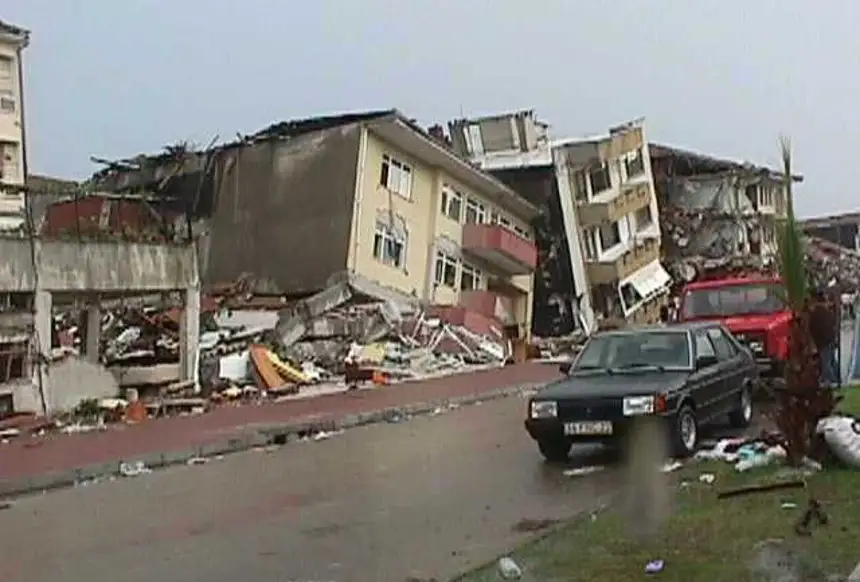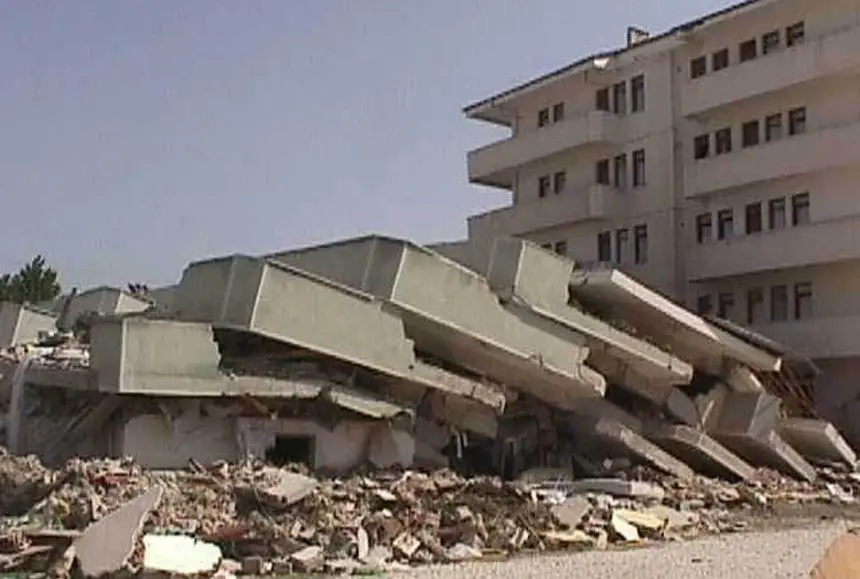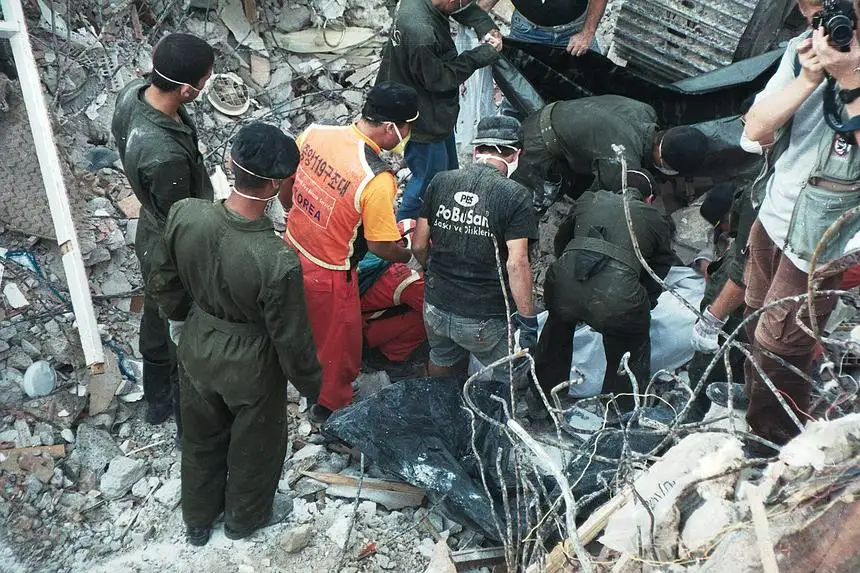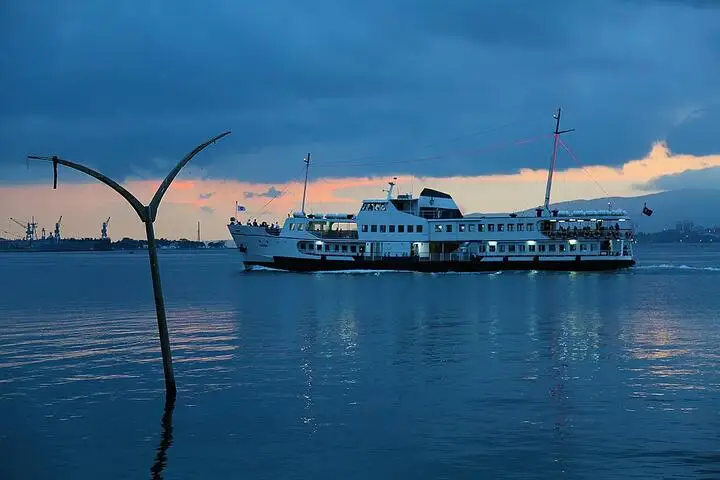History of Türkiye’s most devastating earthquakes: 1999 Izmit and 2023 Kahramanmaraş

Türkiye is located in a seismically active zone with a history of earthquakes. The country is located at the meeting point of the African and Eurasian tectonic plates, which causes frequent seismic activity. Besides them, several active fault lines run through the country, which also contributes to the risk of earthquakes. Earthquakes are a common phenomenon in Türkiye, yet disaster preparedness can be questioned, as lessons do not seem to have been learned from the 1999 Izmit earthquake.

Photo: US Navy/Getty Images
İzmit is a city in Türkiye, located in the Marmara region of the country, about 100 kilometers southeast of Istanbul and is one of the largest cities in the region. İzmit has a population of over 300,000 at the time of the earthquake and is an important industrial center with several large oil refineries and petrochemical plants.
The 1999 Izmit earthquake, also known as the Kocaeli earthquake, was a devastating disaster that struck the Izmit region of Türkiye on August 17, 1999. The earthquake had a magnitude of 7.4 and struck at around 3:01 a.m. local time. It was one of the deadliest earthquakes in Turkish history, killing over 17,000 people and injuring more than 50,000. According to the United Nations Office for Disaster Risk Reduction data, an area affected by the earthquake reached 31,250 square kilometers.
The earthquake also caused tremendous damage to buildings, roads, and infrastructure, with some areas completely destroyed. Hundreds of thousands of people were left homeless because of the disaster.
The earthquake was caused by the North Anatolian Fault, a major geological fault line that runs through Türkiye. The fault has been the source of several large earthquakes in the country's history, and the 1999 Izmit earthquake is considered one of the most devastating events to occur along this fault line in recent times.

Photo: wikipedia.org
In the aftermath of the earthquake, relief efforts were launched to help the affected population. Emergency responders, including medical personnel and rescue teams, were sent to the affected area, and temporary shelters were set up for those who were left homeless. The Turkish government also launched a massive rebuilding effort, with assistance from international organizations and foreign countries.
The 1999 Izmit earthquake was a tragic event that stressed the importance of preparedness and resilience in the face of natural disasters.
Before the Izmit earthquake, the country suffered more than 112 earthquakes that killed over 81,000 people, according to the UN report.

Photo: wikipedia.org
Economic damage caused by the Izmit earthquake
According to the World Bank, the earthquake incurred an estimated $5 billion in damage to the Turkish economy, nearly 2.5 percent of the country’s gross national product.
Izmit is a center for major industries, including refining and petrochemicals. The earthquake affected nine provinces, which according to a 2001 study published by the United Nations Office for Disaster Risk Reduction, comprise 45 percent of the country’s industry and nearly one-third of the country’s gross domestic product. The region is also home to 23 percent of the country’s population (at the time).
The 1999 earthquake hit when the country faced an economic slowdown with significant capital outflows and a recession.
«Between 1995 and 1998, the Turkish economy grew. GDP averaged 7.5 percent in 1997 and peaked at 8.7 percent in the first quarter of 1998. Consumer prices, which had been steady at around 75 percent in 1987, moved about 100 percent in early 1998,» reads the UN study.
Fire resulting from the earthquake caused significant damage to Türkiye’s $2.5 billion refinery at Tupras, the largest oil refinery in Türkiye and one of the largest in Europe. Tupras processes crude oil into a range of products, including gasoline, diesel, jet fuel, and other petrochemical products. The company also operates a network of retail gasoline stations throughout Türkiye.

Photo: wikipedia.org
«It was the keystone of the privatization program that was scheduled to begin in 2000. No refinery elsewhere in the world had been so heavily damaged since the 1964 earthquake In Japan,» said the UN study.
Besides the direct effects, Türkiye had to handle the tremendous indirect social and economic effects, such as a shortfall in the output of goods and services and the cost the country had to provide while the capacity at its facilities was restored.
Laws and regulations on earthquakes in Türkiye
The country’s regulations on how to prevent and mitigate earthquakes are not very stringent. Türkiye tightened the legislation after the 1939 earthquake, which called for risk assessment, safe building practices, and preparation of emergency aid and relief programs. While the laws might be in place, the problem is in their implementation.

Фото: gazeteduvar.com.tr
Some experts noted that the legislation does not cover vulnerable groups of the population that live in isolated areas or are engaged in activities not recognized by the government.
«Türkiye is furthermore confronted with the problems of rapid population growth and the proliferation of urban settlements and industries spreading into vulnerable regions and increasing the risks of human and material losses as well as pollution. This was the background to the Izmit earthquake, where the losses were foreseeable and could have been avoided if preventive measures had been taken to deal with the impending danger,» said the UN report, referring to the 1995 study of the Izmit region.

Photo: wikipedia.org
After the 1999 devastating earthquake, the Turkish government passed several laws to improve earthquake preparedness. They dealt with building code reforms, earthquake zoning, risk reduction and emergency management, research and development, public awareness, and education. Despite these efforts, earthquakes remain a significant hazard in the country.
Latest developments on the Kahramanmaras earthquake
The search and rescue operations continue for an entire week. The death toll in Türkiye reached at least 31,643 people, according to Turkish Emergency Coordination Center SAKOM. President of Türkiye Recep Tayyip Erdoğan declared a national mourning following the deadly quakes that hit the country.
While global attention is on Türkiye, it is not the only country that is reeling from the consequences. There is also Syria, where at least 3,576 people were killed, though the death toll was not updated for two days. Numbers in Syria, which has been torn by war for the past 11 years, are reported from government-controlled and opposition-held territories.

Photo:Serdar Timur, wikipedia.org
Officials say numbers will keep rising as hundreds remain under the rubble. While hopes for finding survivors are fading with seven days passed since the quake, stories keep emerging on social media and the news about people found alive after being stuck for hours under the rubble.
Volunteers continue arriving in cities and regions affected by the earthquake, bringing supplies and assisting earthquake survivors and the families of victims, who were left homeless.
International support is also coming to Türkiye and Syria. Kazakhstan is among the countries that provided support to the two countries. On February 8, an aircraft carrying a second Kazakh rescue team with 60 rescue officers landed in Gaziantep, reported the Kazakh emergency situations ministry.

Photo: aa.com.tr
The newly arriving rescuers were sent to specific areas to join rescue efforts immediately, the ministry said in a statement.
The first aircraft, with 41 rescuers and health workers, departed for Gaziantep on February 7.
According to the Kazakh Ministry of Emergency Situations, the Kazakh rescuers saved seven people from the debris of the deadly quake, and pulled out 53 people, who were found dead.
On February 8, Kazakh President Kassym-Jomart Tokayev instructed the government to allocate $1 million in emergency aid to Türkiye.
Tokayev also instructed his government to provide assistance to Syria through the Organization of Islamic Cooperation. On February 11, a jet carrying 50 tons of humanitarian aid arrived in Aleppo with the support of the Islamic Organization of Food Security. Kazakhstan sent canned food, warm clothes, winter tents, beds and bedding from the state reserve. The humanitarian aid is being delivered to the city of Aleppo in four flights by the National Guard of Kazakhstan.
According to the spokesperson of the Kazakh Foreign Ministry Aibek Smadiyarov, more than 160 million tenge (US$353,816) were allocated from the budget for humanitarian aid to Syria.
The deadly earthquake also killed two Kazakh citizens, Adil Kadyrbekov and Mirbolat Kurmashev.
Three Kazakh nationals and one Turkish citizen with them were reported missing, according to the Kazakh Foreign Ministry’s statement published on its Telegram channel on February 8. One of them, Sabina Mamadyarova, was found alive. Kurmashev and Kadyrbekov, however, were found dead by rescuers.
«The condition of Sabina Mamadyarova, a survivor of the earthquake, is known that she is in the Adana State Hospital. Yesterday she underwent surgery on her injured arm. She is stable. Diplomats are in constant contact with doctors. She is receiving the necessary medical care. The consul will visit her personally today. Since the news came out about the earthquake in Türkiye, the ministry's 24-hour hotline has received more than 1,000 calls. Most of the people who called were looking for their relatives in Türkiye,» said Smadiyarov at a press briefing on February 10.
A second group of Kazakh citizens was evacuated on February 9 on a special flight, said the Kazakh Foreign Ministry. There are 42 Kazakh citizens and 22 citizens of Kyrgyzstan.
The Kazakh citizens were evacuated from Gaziantep, Mersin, Kahramanmaras, Diyarbakir, and Şanlıurfa provinces. The first aircraft carrying 16 Kazakh citizens were evacuated to Kazakhstan on February 7.
Main photo: Sergei Chirikov / AFP